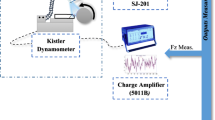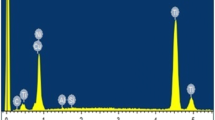Abstract
The present study was carried out to perform predictive modelling of material removal rate (MRR) and tool wear rate (TWR) during ultrasonic machining (USM) of titanium (Ti) alloy (Ti–6Al–4V) by realizing an optimum artificial neural network (ANN) created by exploring the effect of two different learning algorithms with varied number of neurons in hidden layer. Experimental studies were carried out to explore the effect of various process parameters of ultrasonic machining on response variables MRR and TWR. The basic nature of USM makes these two variables a conflicting one and, therefore, an entropy weight-based grey relational method was used to optimize the process for the two response variables. It was found that the ANN-based predictive results were very closely related to actual experimental findings.















Similar content being viewed by others
References
Thoe TB, Aspinwall DK, Wise MLH (1998) Review on ultrasonic machining. Int J Mach Tools Manuf 38(4):239–255
Lin YC, Yan BH, Chang YS (2000) Machining characteristics of Ti alloy (Ti–6Al–4V) using a combination process of EDM with USM. J Mater Process Technol 104:171–177
Wansheng Z, Zhenlong W, Shichun D, Guanxin C, Hongyu W (2002) Ultrasonic and electric discharge machining of deep and small hole in Ti alloy. J Mater Process Technol 120:101–106
Churi NJ, Li ZC, Pei ZJ, Treadwell C (2005) Rotary ultrasonic machining of Ti alloy: a feasibility study. In: Proceedings of IMECE 2005 ASME, Orlando, Florida, USA November 5–11
Churi NJ, Pei ZJ, Treadwell C (2007) Rotary ultrasonic machining of Ti alloy (Ti–6Al–4V): effect of tool variables. Int J Precis Technol 1(1):85–96
Singh R, Khamba JS (2006) Machining of Ti and its alloys: a review. J Mater Process Technol 173:125–135
Dwiivedi A, Kumar P (2007) Surface quality evaluation of ultrasonic drilling through Taguchi technique. Int J Adv Manuf Technol 34:131–140
Singh R, Khamba JS (2007) Investigation for ultrasonic machining of Ti and its alloys. J Mater Process Technol 183:363–367
Singh R, Khamba JS (2007) Macromodel for ultrasonic machining of Ti and its alloys: designed experiments. J Eng Manuf IMechE Part B 221:221–229
Kumar J, Khamba JS, Mohapatra SK (2008) An investigation into the machining characteristics of Ti using ultrasonic machining. Int J Mach Mach 3(1–2):143–161
Dhuria GK, Singh R, Batish A (2011) Ultrasonic machining of Ti and its alloys: a state of art review and future perspective. Int J Mach Mach Mater 10(4):326–355
Mohan Lal D, Renganarayanan S, Kalanidhi A (2001) Cryogenic treatment to augment wear resistance of tool and die steels. Cryogenics 41:149–155
Baron FR (1974) Yes—cryogenic treatment can save you money! Here’s why. Tapi 57(5):35–40
Paulin P (1993) Frozen gears. Gear Technol 10(2):26–28
Huang JY, Zhu YT, Liao XZ, Beyerlein IJ, Bourke MA, Mitchell TE (2003) Microstructure of cryogenic treated M2 tool steels. Mater Sci Eng A399:241–244
Yuan-zhi Z, Zhi-min Y, Yong Z, Quan-Feng L, WenShang F (2008) Effects of cryogenic treatment on material properties and microstructure of Fe–Cr–Mo–Ni–C–Co alloy. J Cent South Univ Technol 15:454–458
Das D, Dutta AK, Ray KK (2008) On enhancement of wear resistance of tool steels by cryogenic treatment. Philos Mag Lett 88(11):801–811
Cajner F, Leskovesk V, Landek D, Cajner H (2009) Effect of deep cryogenic treatment on high speed steel properties. Mater Manuf Process 24(7):743–746
Joseph Vimal A, Bensely A, Mohan Lal D, Srinivasan K (2008) Deep cryogenic treatment improves wear resistance of En31 steel. Mater Manuf Process 23(4):369–376
Das D, Datta AK, Toppo V, Ray KK (2007) Effect of deep cryogenic treatment on the carbide precipitation and tribological behavior. Mater Manuf Process 22(4):474–480
da Silva FJ, Franco SD, Machado AR, Ezugwu EO, Souza AM Jr (2006) Performance of cryogenically treated HSS tools. Wear 261:675–685
Das D, Ray KK (2012) On the mechanism of wear resistance enhancement of tool steels by cryogenic treatment. Philos Mag Lett 92(6):295–303
Senthilkumar D, Rajendran I (2012) Optimization of deep cryogenic treatment to reduce wear loss of 4140 steel. Mater Manuf Process 27(5):567–572
Amini K, Akhbarizadeh A, Javadpour S (2012) Effect of deep cryogenic treatment on formation of nano sized carbide and the wear behavior of D2 tool steel. Int J Miner Metall Mater 19(9):795–799
Kim JW, Griggs JA, Regan JD, Ellis RA, Cai Z (2005) Effect of cryogenic treatment on nickel Ti endodontic instruments. Int Endod J 38(6):364–371
Kumar J, Khamba JS (2010) Modeling the material removal rate in ultrasonic machining of Ti using dimensional analysis. Int J Adv Manuf Technol 48:103–119
Kumar V, Khamba JS (2009) Parametric optimization of ultrasonic machining of co-based superalloy using the Taguchi multi-objective approach. Prod Eng Res Develop 3:417–425
Kataria R, Kumar J, Pabla BS (2016) Experimental investigation and optimization of machining characteristics in ultrasonic machining of WC–Co composite using GRA method. Mater Manuf Process 31(5):685–693
Kumar J, Khamba JS (2008) An experimental study on ultrasonic machining of pure titanium using designed experiments. J Braz Soc Mech Sci Eng 30(3):231–238
Kaixuan G, Zhang H, Zhao B, Wang J, Zhou Y, Li Z (2013) Effect of cryogenic treatment and aging treatment on the tensile properties and microstructure of Ti–6Al–4V alloy. Mater Sci Eng A 584:170–176
Molinari A, Pellizzari M, Gialanella S, Straffelini G, Staisny KH (2001) Effect of deep cryogenic treatment on mechanical properties of tool steels. J Mater Process Technol 118(1–3):350–355
Prieto G, Perez Ipina JE, Tuckart WR (2014) Cryogenic treatments on AISI420 stainless steel: microstructure and mechanical properties. Mater Sci Eng A605:236–243
Sivasankar S, Jeyapaul R (2012) Application of grey entropy and regression analysis for modelling and prediction on tool materials performance during EDM of hot pressed ZrB2 at different duty cycles. Procedia Eng 38:3977–3991
Wen KL, Chang TC (1998) The grey entropy and its application in weighting analysis. Proc IEEE Int Conf Syst Man Cybern 2:1842–1844
Singh R, Khamba JS (2009) Mathematical modeling of tool wear rate in ultrasonic machining of Ti. Int J Adv Manf Technol 45(5–6):573–580
Vijay Kumar K, Naveen Sait A (2014) Modelling and optimization of machining parameters for composite pipes using artificial neural network and genetic algorithm. Int J Interact Des Manuf. doi:10.1007/s12008-014-0253-0
Kumar S, Batish A, Singh R, Singh TP (2014) A hybrid Taguchi-artificial neural network approach to predict surface roughness during electric discharge machining of Ti alloys. J Mech Sci Technol 28(7):2831–2844
Krishna Mohana Rao G, Rangajanardhaa G, Hanumantha Rao D, Sreenivasa Rao M (2009) Development of hybrid model and optimization of surface roughness in electric discharge machining using artificial neural networks and genetic algorithm. J Mater Process Technol 209:1512–1520
Pandey AK, Dubey AK (2013) Modeling and optimization of kerf taper and surface roughness in laser cutting of Ti alloy sheet. J Mater Sci Technol 27(7):2115–2124
Sahu SN (2012) Neural network modelling and multi-objective optimization of EDM process. Thesis, NIT Rourkela
Kara F, Aslantas K, Cicek A (2015) ANN and multiple regression method based modelling of cutting forces in orthogonal machining of AISI 316L stainless steel. Neural Comput Appl 26:237–250
Kant G, Sangwan KS (2015) Predictive modelling and optimization of machining parameters to minimize surface roughness using artificial neural network coupled with genetic algorithm. Procedia CIRP 31:453–458
Author information
Authors and Affiliations
Corresponding author
Additional information
Technical Editor: Márcio Bacci da Silva.
Rights and permissions
About this article
Cite this article
Dhuria, G.K., Singh, R. & Batish, A. Application of a hybrid Taguchi-entropy weight-based GRA method to optimize and neural network approach to predict the machining responses in ultrasonic machining of Ti–6Al–4V. J Braz. Soc. Mech. Sci. Eng. 39, 2619–2634 (2017). https://doi.org/10.1007/s40430-016-0627-2
Received:
Accepted:
Published:
Issue Date:
DOI: https://doi.org/10.1007/s40430-016-0627-2




